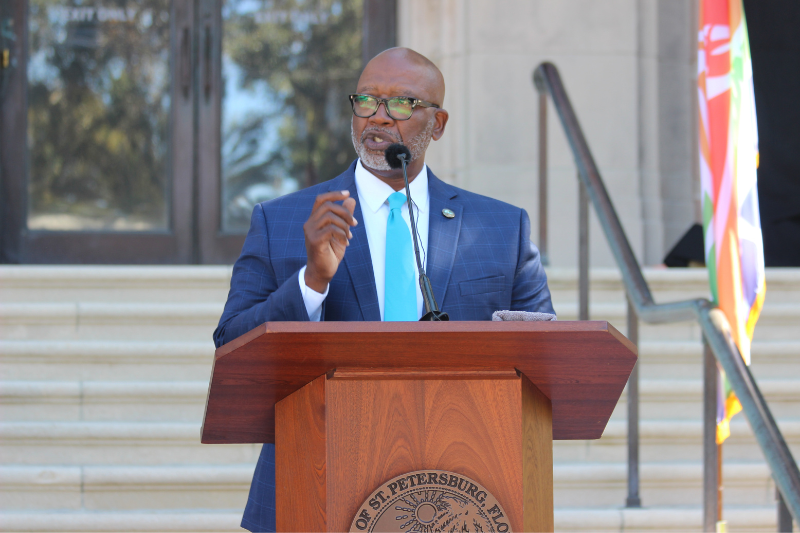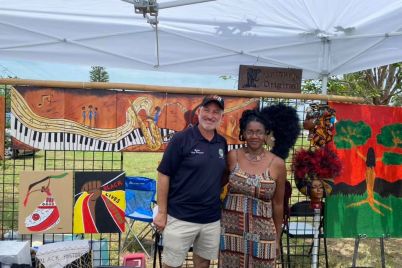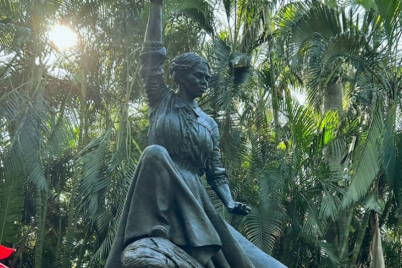The land that Hines/Tampa Bay Rays was chosen to develop has a storied past of mass displacement, racial terror violence, Black homeownership suppression and many broken promises.
BY FRANK DROUZAS, Staff Writer
ST. PETERSBURG — The City of St. Petersburg took a giant step forward in its effort to redevelop the Gas Plant district as Mayor Ken Welch formally announced the group selected to lead the project.
During his 2023 State of the City address on Jan. 30, Welch revealed that the Hines/Tampa Bay Rays group would take the reins to redevelop the 86 acres of property, which includes Tropicana Field. The group beat three other finalists vying for the project, including 50 Plus 1 Sports, Restoration Associates and Sugar Hill Community Partners.
The Houston-based Hines and Tampa Bay Rays group proposal includes 5,700 multifamily units and 600 senior living residences, with more than 850 affordable and workforce housing units on-site and about 600 such homes off-site. It also includes a new Woodson African American Museum of Florida.
The history of the Gas Plant district, the mayor said, is the story of “a dream deferred.” But through the city’s collective perseverance, collaboration and intentional actions moving forward, it will no longer be a dream denied.
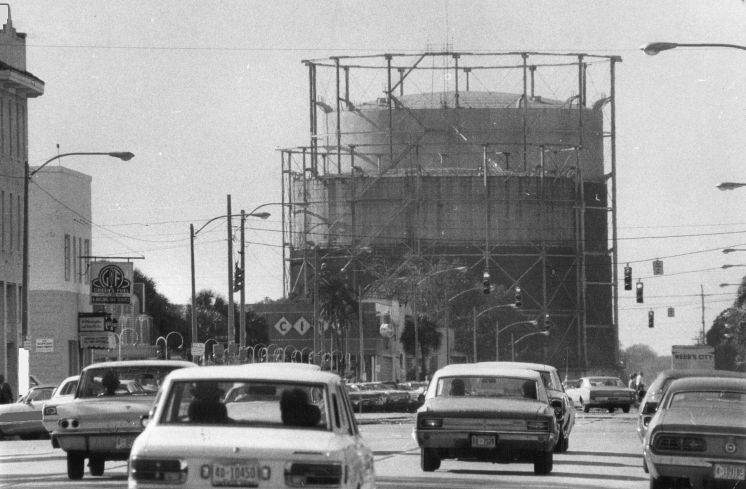
From 1906 to 1986, African Americans suffered at least 10 displacements from the Gas Plant and adjacent Peppertown neighborhoods. These incidents forced the relocation of hundreds of Black households in groups ranging from 10 to 500 households at a time. [St. Petersburg Times]
The promise, Welch continued, was that this land would benefit all because development would be focused intentionally on economic inclusion for all. The best path for progress is the path that includes opportunities for everyone, and in St. Petersburg, history does matter, he stressed.
“As I made the decision to issue a new RFP last year, it was not so much a comment on the previous RFP, but rather a realization of the opportunities that I believe exist for a better path forward,” Welch said. “Based on our governing principles, we took advantage of that opportunity to build a better path forward by galvanizing our relationships with our partners, including our city council, the Pinellas County Commission and the Tampa Bay Rays, relative to the stadium, and the community.”
The mayor pointed out that he saw a need for prioritizing the community’s need for affordable and workforce housing, on-site and off-site, and the avenue for restorative economic opportunities needed to be a clearly stated and understood priority.
“In total, this RFP and the responses to it give us that opportunity to a better path to write the next chapter of our story, to meet many though not all of our collective needs for jobs, economic growth, office and meeting space and many other community priorities,” Welch said.
He said it was also an opportunity to fulfill the promise of our obligation to ensure that the economic development that is created from this generational project is rooted in intentional equity, shared opportunities for progress, and meaningful inclusion of the African-American community.
With this announcement, the mayor underscored that he is naming a partner and a concept for a project that will last over a decade and span multiple administrations.
“As the plan moves forward under my administration,” he said, “we will adhere to our model of inclusive governance, asking for input from all stakeholders, including the community, to ensure we are meeting the goals of this development. I know our St. Pete community will stay engaged and informed as this project takes shape.”
Welch said they received staff and consultant analyses of the strengths and weaknesses of the proposals.
“The process was detailed and transparent, and as your mayor, I have done my homework. I am fully confident that this decision is the best path forward for our city.”
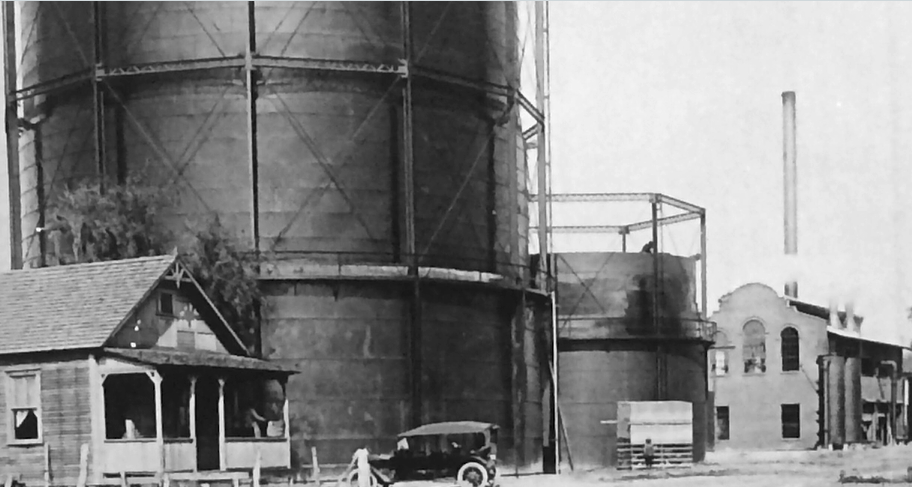
The first displacement found by the Structural Racism Study was in 1906 when the white ‘Vigilance Committee’ posted notices’ ordering negro tenants to vacate buildings on Ninth street near Central Avenue.’
Structural racism is how we got here
As documented by the Structural Racism Study completed last year, the City of St. Petersburg officials, in tandem with openly white supremacist business leaders, created and upheld policies and institutional norms that perpetuated the white-Black economic gaps that existed in the wake of Emancipation and that still exists, only partly abated, in the present.
The result was decades of public policies and investments explicitly designed to enrich whites and limit economic gains and opportunities for African Americans.
These injustices date back nearly 120 years, long before
- the construction of Highway I-175 in 1980 sliced through the heart of the Gas Plant and began the demise of the affluent Black “Sugar Hill” neighborhood
- The 1986 demolition of the neighborhood that once housed the beating heart of St. Petersburg’s African-American community
Types of economic Crimes Perpetrated
Mass Displacements: From 1906 to 1986, African Americans suffered at least 10 displacements from the Gas Plant and adjacent Peppertown neighborhoods. These incidents forced the relocation of hundreds of Black households in groups ranging from 10 to 500 households at a time. The first displacement found by the Structural Racism Study was in 1906 when the white “Vigilance Committee” posted notices “ordering negro tenants to vacate buildings on Ninth street near Central Avenue,” then returned a week later to unleash a “fusillade” of bullets into those homes in the middle of the night. The targets of the attack vacated their homes and moved elsewhere.
Racial Terror Violence: The Gas Plant was the site of nearly all the earliest racial violence acts in St. Petersburg. These vicious acts were often economically motivated and designed to inhibit African Americans’ financial and political prospects. They were often carried out with the participation or permission of city officials and local law enforcement. Well-known is the 1914 lynching of John Evans (a Black man) by a mob of 1,500 white residents, which took place at the northeast corner of the Gas Plant neighborhood. Lesser known are the dynamite bombings of businesses in the black community; the anonymous threats of bodily harm to Black business owners and workers; and the brutal police killings and beatings of Black men and women (including a second lynching not yet publicly recognized and hanging deaths following convictions that were likely wrongful).
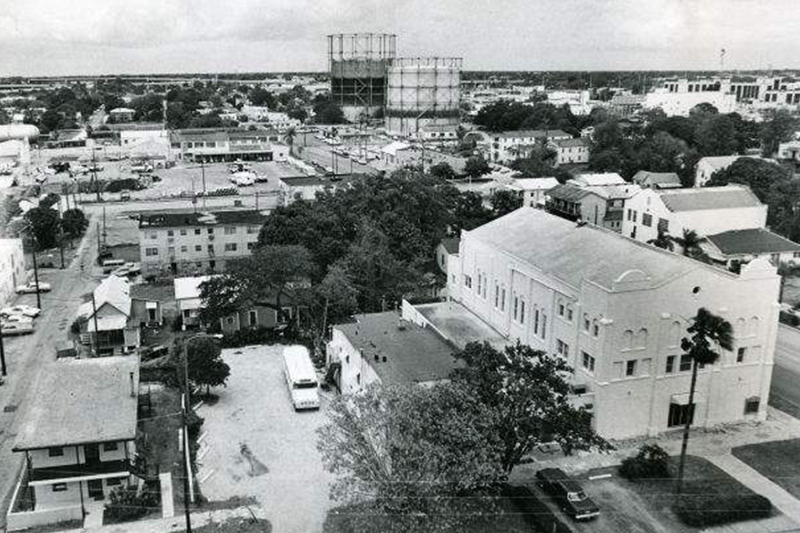
For 70 years, city officials suppressed homeownership rates and home values for African Americans through a latticework of policies and norms. [St. Petersburg Times]
- Collusion between city officials and white property owners to prevent the development of minimum housing standards for black rental housing
- Unlawful denials of construction permits to African-Americans property owners
- Buying properties and encouraging white residents to buy properties to prevent Black residential expansion outside of segregated boundaries
- Blatantly disparate investments in infrastructure and amenities that city officials admitted was a hindrance to Black home seekers securing FHA mortgage loans
According to national studies and local estimates, these actions account for better than a third of the present-day Black-white wealth gap in St. Petersburg.
Labor Control Methods: Local officials and business leaders conspired to suppress the value of Black labor for decades, including the open practice of racial pay disparities and the city’s operation of a convict labor program (with its hub in the Gas plant neighborhood), fueled by vagrancy laws and a comprehensive system of sentencing disparities. This program led to the arrest and forced labor of thousands of African Americans in St. Petersburg (over half of them from the Gas Plant) from circa 1900 to 1946); and robbed Black families of hundreds of millions of dollars in labor lost to public and private chain gangs and labor programs.
Black Wealth Building Battered: In the early 20th century, the Gas Plant neighborhood was one of Florida’s largest concentrations of Black wealth. The area was home to all the earliest African-American real estate developers in St. Petersburg. Their stories have never been told, but by 1925 their holdings encompassed over 100 parcels of commercial land (an impressive feat, given that some were formerly enslaved).
In residential property, the censuses of 1900, 1910, and 1920 show a higher homeownership rate for African Americans in St. Petersburg compared to Blacks across the rest of Florida and/or the nation. This budding enclave of Black wealth was battered and depleted through the countless actions of white power brokers, including likely incidents of land theft; forced buyouts of land; purposeful racial disparities in zoning that diminished property values in Black neighborhoods; the city’s enactment of openly disparate insurance policy values for its employees; collusion among officials and business leaders to limit revenues to Black entrepreneurs and workers, and other.
Many more broken promises
Many of us are aware of the broken promise by city leaders to redevelop the Gas Plant neighborhood in the 1980s. The part of the story often told is that in 1979, the city approved a plan to redevelop the all-black Gas Plant area with commercial spaces that would create 680 jobs paying $20 million in wages (today’s dollars) plus construction jobs over seven years to rehab and build new homes for 1,000+ people.
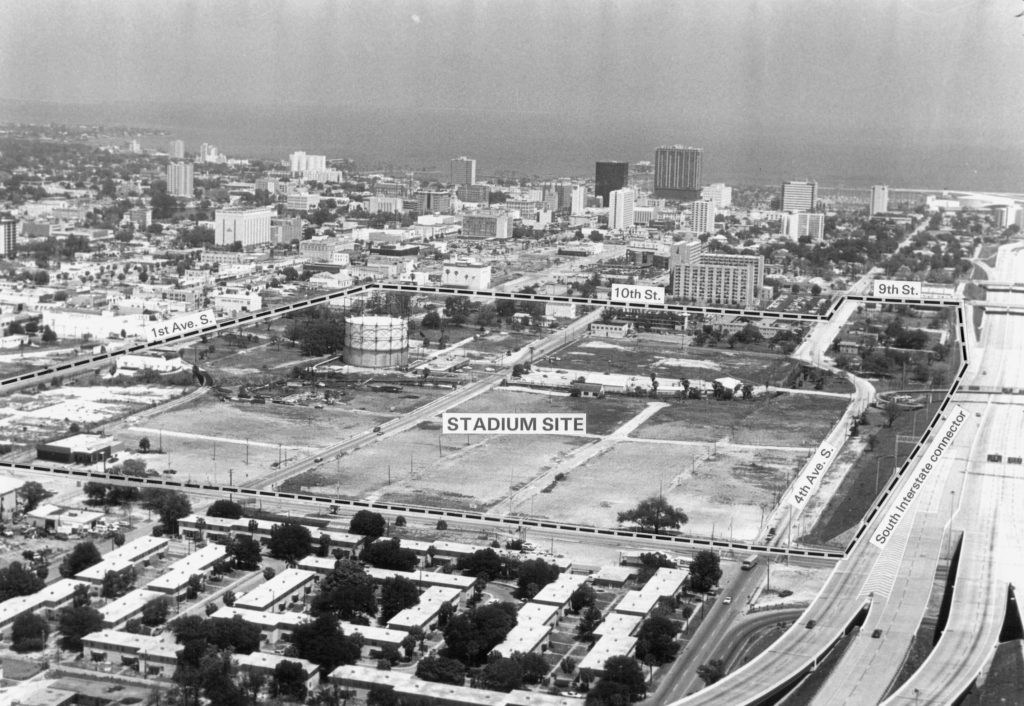
By 1986, the Gas Plant neighborhood was destroyed to make way for the construction of a baseball stadium instead.
But the plan was shelved by the early 1980s when city officials and local business leaders began lobbying to construct a sports stadium. By 1986, the Gas Plant neighborhood was destroyed to make way for the construction of a baseball stadium instead. The project bulldozed 285 buildings, relocated nine churches and 500 households, caused 40 businesses to move or close, uprooted organizations such as the Masons, and demolished 80+ investment properties, many Black-owned.
But the Gas Plant suffered many other broken promises, including:
- Commitments made to former Councilman David Welch and the pastors of three historic Black churches (to win their support for the 1986 displacement) that the demolition would result in economic opportunities and growth for the community.
- The commitment to minority business participation during the construction of the Sundome (now Tropicana Field) in 1986
- The commitment to minority business participation during the renovation of Tropicana Field in 1997
- The 1909-1910 commitment to build a new school for Black children in Gas Plant
- The 1935 abandonment of a plan to build affordable housing on the site of Campbell Park
- The 1953 plan to build a community center for Black youth
- And others
So much Black history unfolded on these acreages, largely because the Gas Plant was the largest of the original three all-Black neighborhoods in St. Petersburg.
The Gas Plant neighborhood is also home to:
- The first park open to African Americans – Campbell Park was built largely through the contributions and volunteerism of Black residents, including the philanthropy of the Diamond Mutual Progressive League (of Black entrepreneurs)
- Three of the first four Black churches founded in our city
- The first Black civic organization in St. Petersburg – the Masons and the Masonic Lodge
- The first Black school in St. Petersburg
- And so much more
This short summation, compiled by Gypsy Gallardo of One Community and The Power Broker Magazine, can be found in its entirety in the Structural Racism Study.

